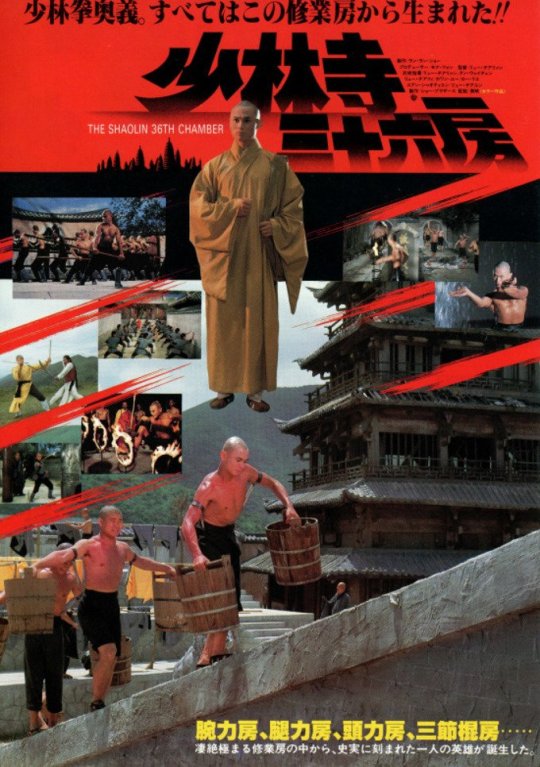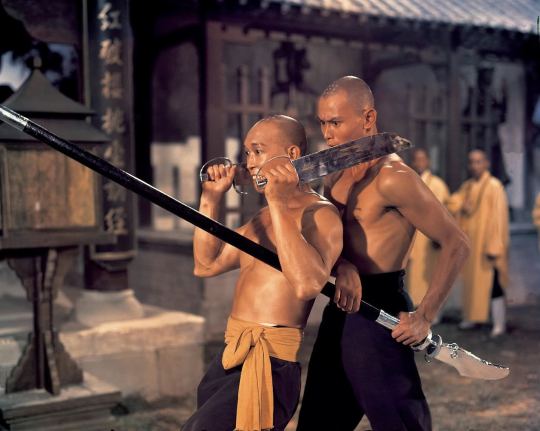#The 36th Chamber of Shaolin
Explore tagged Tumblr posts
Text







The 36th Chamber of Shaolin [少林三十六房] (1978), dir. Lau Kar-leung
24 notes
·
View notes
Text

123 notes
·
View notes
Text

The 36th Chamber of Shaolin (1978)
#movies#posters#shaw bros.#gordon liu#lau kar leung#the 36th chamber of shaolin#kung fu movies#favorites
17 notes
·
View notes
Text

1978: the 36th chamber of Shaolin. IMDb 7.6
6 notes
·
View notes
Text
462 to go
Louisiana Story (1948, dir. Robert Flaherty): The setting is lovely and beautifully shot but man did this one bore me.
The Man Who Had His Hair Cut Short (1966, dir. André Delvaux): The protagonist is such a wet tissue of a human being but that just makes this story of devastating, all-encompassing obsession work all the better.
Pierrot le Fou (1965, dir. Jean-Luc Godard): This project has fully Stockholm Syndromed me into enjoying Godard.
The 36th Chamber of Shaolin (1978, dir. Lau Kar-leung): Not really my cup of tea but it's very well made and surprisingly funny.
Shoot the Piano Player (1960, dir. François Truffaut): Truffaut has always been a bit too esoteric for me but that wasn't the case here - I actually loved this movie! What can I say, I can't resist a pathetic male lead or witty, foul-mouthed waitresses, not to mention how beautiful the film looks - Paris in the 1960s is ever charming.
Bigger Than Life (1956, dir. Nicholas Ray): A beautifully crafted, nightmarish melodrama. Obviously the science is 100% bullshit but the anxiety and fear are very real. It also kind of shocked me how openly critical it is of at those at the time sacred concepts of the American Dream, the noble patriarch and the nuclear family.
Body Heat (1981, dir. Lawrence Kasdan): A very fun little piece of 80s sleaze. Kathleen Turner is mesmerizing, a modern day (at the time) Lauren Bacall. And people really aren't sweaty enough in modern day cinema.
The Five Venoms (1978, dir. Chang Cheh): Actually, I think I'm starting to get this genre. The structure felt strange to me but the plot was gripping and the characters fun, if not particularly complex (Toad was my favorite). The amount of awful wigs - and fake beards! - delighted me to no end.
#1001 movies#louisiana story#the man who had his hair cut short#pierrot le fou#the 36th chamber of shaolin#shoot the piano player#bigger than life#body heat#the five venoms
2 notes
·
View notes
Text
Quick Takes: Second-Hand Kung Fu
There are currently 8,867 films on my Letterboxd watchlist, and roughly 8,000 of them will remain unwatched for all eternity. Every time a movie looks interesting to me, I toss it into the bottomless watchpit, with no concrete plans to dig it up at any particular time. Either it’ll tumble out of the Shuffle button at the exact right moment or it will rot there forever, and I think that’s…

View On WordPress
#action#angela mao#brandon ledet#bruce li#brucesploitation#chang cheh#Chen Kuan-tai#gordon liu#jimmy wang#kung fu#Lists & Articles#martial arts#paul l smith#return of the tiger#rza#shaw brothers#the 36th chamber of shaolin#the iron monkey#the one-armed swordsman
0 notes
Text

The 36th Chamber of Shaolin
1978
#The 36th Chamber of Shaolin#martial arts#martial law#right to bear arms#civil rights#2nd amendment#2a
0 notes
Text

The 36th Chamber of Shaolin, Lau Kar-leung, 1978
1 note
·
View note
Text



Gordon Liu, Lee Hoi-Sang - The 36th Chamber of Shaolin (1978)
#gordon liu#lee hoi sang#lau kar leung#36th chamber of shaolin#shaolin temple#shaw brothers#hong kong cinema#hong kong action#action choreography#martial arts cinema
100 notes
·
View notes
Text

少林寺三十六房 東映株式会社映像事業部 監督=リュー・チアリァン(ラウ・カーリョン)/出演=リュー・チアフィ(リュー・チャーフィー) ほか
#THE SHAOLIN 36TH CHAMBER#少林寺三十六房#Lau Ka-Leung#劉家良#Liu Chia-Hui#gordon liu#劉家輝#anamon#古本屋あなもん#あなもん#映画パンフレット#movie pamphlet
62 notes
·
View notes
Text
help me decide which ones to prioritise before my mubi membership runs out! and please feel free to tell me why or recommend multiple films (or one i haven't mentioned)!
#shaw brothers#wuxia#36th chamber of shaolin#the 8 diagram pole fighter#dirty ho#five element ninjas#the one armed swordsman#intimate confessions of a chinese courtesan#my polls#the shaw brothers back catalogue is sooooo long and i'm so00 indecisive#these are just ones that caught my eye but i'm happy to add others to my watchlist as well#chang cheh#lau kar leung
8 notes
·
View notes
Text
This is the hammer Gordon Liu had to hit that big bell with in 36th Chamber of Shaolin.
El martillo de los Looney Tunes:
10K notes
·
View notes
Photo

Lee Hoi-Sang and Gordon Liu in Lau Kar-leung movie The 36th Chamber of Shaolin
53 notes
·
View notes
Note
imagine annie "pranking" armin with a bra that hooks in the front or just doesn't have a hook so when he goes to take it off he just kinda... blue screens. the fuck is he supposed to do?
Anon, have you seen the movie "The 36th Chamber of Shaolin"???
The thing about being around Pieck is that when she finds out Aruani are goddamn shy virgins who only did the deed like... a week ago, she decides: these two need training.
Okay, scratch that, Annie can manage (there's not all that much to learn about men's clothes, they don't have clips and pins and buttons - only very deep pockets 🥲), but... Armin.
Armin's the one who needs training.
See there's a million different kinds of women's underclothes in the market and they're all so cute and Pieck's making sure Annie's in ALL of them (but like, not at the same time, Armin would cry). When you're too tired to dress up sexy, you make your best friend dress up sexy, turn the key in her back, and march her off into battle.
And it is kind of a battle? The first time Armin encounters The Bra, he's baffled. It takes him a good while to figure out how it works and they both combust of embarrassment in the process. Way to go in trying to be smooth and confident. Thank god he's too lightheaded or he would've studied the stitch pattern and drawn a diagram because woah such precise mechanics!
Hormones save the day.
From there Pieck gently works Aruani up to higher chambers of wisdom and enlightenment. Bras with hooks, bras without hooks, bras that don't look like bras, bras that separate in several pieces, stockings with clips, stockings without clips, garter belts, other sexy lingerie that even the devil would be embarrassed about seeing...??
Armin's (aided) ascent to the 35th Chamber is full of blue screens, program crashes, device errors, freezes, short circuits and brain-jams but so so good 🥺
#tho anon; you really reminded me of a touken fanart by neimana about exactly this thing xD#I'm gonna reblog it after this posts#askies#aruani#headcanon#armin arlert#attack on titan#shingeki no kyojin#annie leonhart#snk#aot#aruannie#armin x annie
25 notes
·
View notes
Text


(source)
Meniscus cleaning complete
Thank you, doctor
I didn't actually want to see it, but the doctor sent me a photo of the inside of my knee on LINE... The part that's supposed to be all smooth was like a broken pair of disposable chopsticks and the surface was rough.
Some tearing was also found, so I'll be joining the Painful Injection Association as well...
Nothing to be done about it.
Post op
I thought, nooo problem, and figured, I'll get out of my room and take a walk
But even with crutches, just walking to the convenience store in the hospital was sweaty and painful
Ahh
Just from that, I was sweating like crazy, I felt like I was about to barf, and my heart rate went up
The pressure bandages on my feet are like Adon or the 36th Chamber of Shaolin or something
When the time comes, what should the name of my return be?
Super Hyper Mode Desperado Ⅱ Returns Coming Home Second Season Great Revised Edition Perfect The Second FA-78-1 NEW
..... I guess it doesn't need a name.
#el desperado#njpw#my translation#get well soon despe#I'm sure that all of these names are from movies games and anime but most of them are going right over my head unfortunately#FA-78-1 is an upgraded Gundam and Hyper Mode is from Seisenshi Danbain...#But knowing Desperado I'm sure all of these are specific references#Oh and Adon is Adon from Street Fighter!
39 notes
·
View notes
Text
it got up to over a second and i had to give up...sad
this version of Shaft i'm watching has extreme audio desync and it's driving me crazy
5 notes
·
View notes